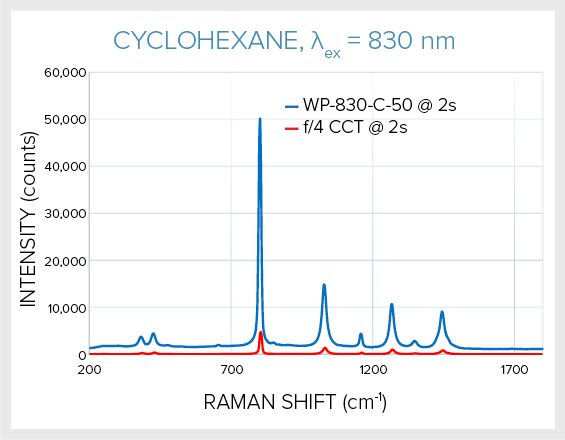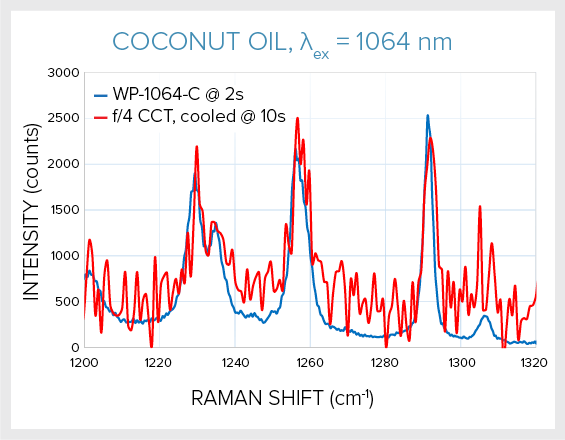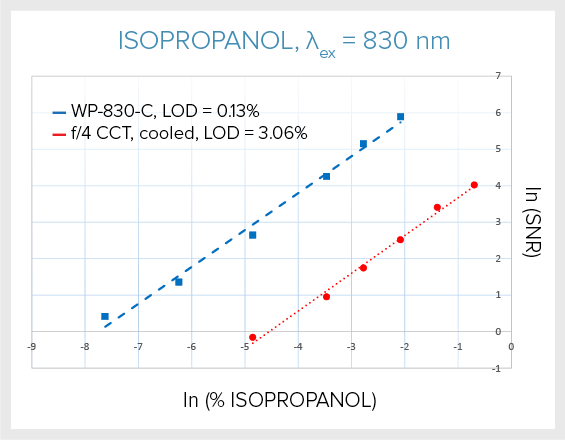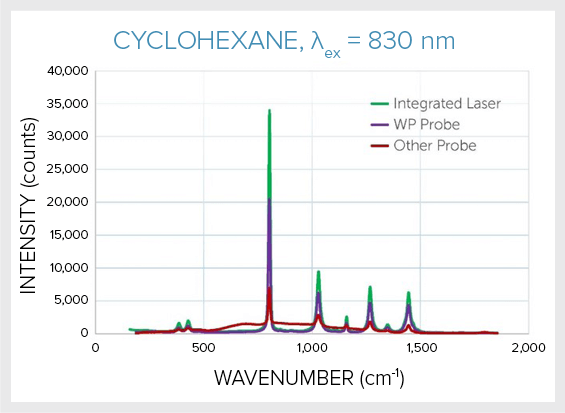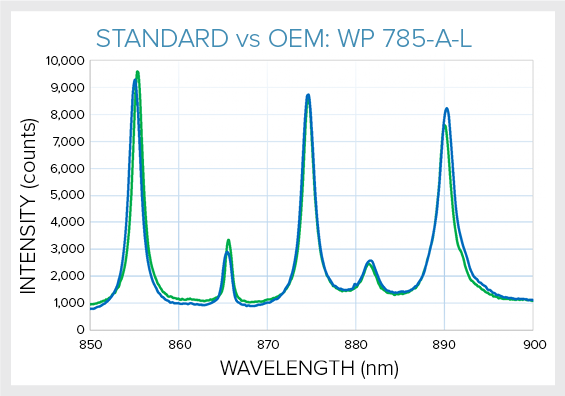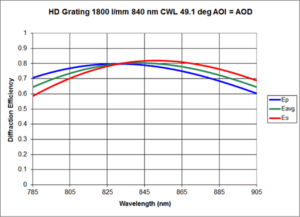A step change in performance for portable Raman
Raman has come into its own over the last decade, making the leap from lab to industry and the field with handheld and field-portable analysis systems. As with many technologies, however, the reduction in size has often meant a compromise in performance as compared to traditional benchtop Raman systems. This has limited the applications in which portable Raman spectroscopy can be applied, and/or the detection limit that can be achieved. It is, however, possible to extend the reach of portable Raman to close this gap and enable new applications through careful product design that optimizes sensitivity, size, and wavelength.
Design of a portable system for Raman that delivers performance approaching a benchtop system requires attention to three key parameters that can benefit both researchers and OEMs:
- Sensitivity – use of better optical designs to deliver significantly more throughput in the same compact footprint without adding significant cost
- Miniaturization – robust, intelligent mechanical design that reduces footprint while delivering excellent thermal stability and unit-to-unit reproducibility
- Wavelength – optimization of analysis wavelength(s) to get the best SNR for each sample
In this tech note, we’ll look at design options to optimize each, and how they can stretch the limits of applied Raman spectroscopy by providing a step change in the performance traditionally available through compact spectrometers, as well as available products.
Sensitivity – The Wasatch Advantage
Sensitivity is extremely important, as it is key to some of the most interesting emerging commercial Raman applications: trace level detection, through-package analysis, high-throughput inspection, and tagging. The conventional compact crossed Czerny-Turner (CCT) fiber optic spectrometers that have been on the market for 20 years are able to serve many routine identification needs, but still fall short of benchtop spectroscopy systems by 1-2 orders of magnitude due to the limitations in this particular optical layout. A better optical design is needed to deliver significantly more throughput in the same compact footprint.
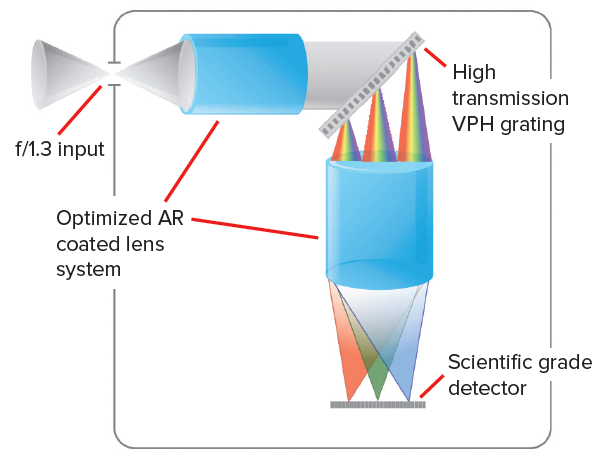
The first miniature spectrometers were designed for “good enough” spectroscopy, using the lowest cost possible components in the most compact configuration to achieve a single-shot spectrum with resolution and sensitivity adequate for routine absorption or reflection spectroscopy. Their numerical aperture was chosen to match the most common multimode fibers available – 0.22 NA – and thus use an f/4 optical design. An f/4 crossed Czerny-Turner (CCT) optical layout using reflective optics keeps size to a minimum, but at a cost: the asymmetric design results in a curved image plane onto the detector, making it more difficult to correct for optical aberrations, and degrading peak symmetry with temperature. While many applications are well-served by this design, it must work harder at the two key performance parameters most important in applied portable Raman spectroscopy – sensitivity and thermal stability.
Our compact spectrometer designed specifically for Raman takes a different approach – by working in transmission instead of reflection, optical aberrations can be reduced to below the diffraction limit, decreasing stray light in the system and achieving consistently good focus across the detector image plane for more signal. Use of transmissive VPH gratings offers an additional 20-40% increase in efficiency over the reflective gratings used in CCT spectrometers, as well as a more smoothly varying response curve and less scatter. Sensitivity gains can be amplified even further by increasing the collection angle to 42° (f/1.3 vs the typical f/4 of a CCT spectrometer, or a 0.36 NA). Together, these factors result in >10x more signal by design. This improvement in optical design translates into several concrete advantages in terms of relative performance, described below.
Higher Sensitivity
Measurement of cyclohexane with 830 nm excitation using our transmissive f/1.3 spectrometer design yielded 10x more signal in the same measurement time than a conventional f/4 reflective CCT spectrometer, allowing smaller peaks to be easily seen and quantified. This is ideal when capturing brief phenomena, or for detection of weak signals. With higher sensitivity, lower laser power levels can be used, minimizing radiant exposure. This avoids damage to delicate samples, and reduces risk when identifying potentially explosive unknowns in the field.
Shorter integration times
A conventional f/4 reflective CCT spectrometer required 10 s to acquire a scan of coconut oil using 1064 nm excitation with measurable peaks. Our 1064 nm transmissive f/1.3 spectrometer acquired the same amount of signal with significantly less noise in just 2 s, allowing peak structure at 1220-1240 cm-1 to be easily resolved. In fact, at this scan rate, averaging could be used to maximize SNR even further. Rapid measurements are ideal for high-throughput scanning in process and industry, and allow better spatial resolution images to be acquired in equivalent time during 2D mapping.
Lower limit of detection
While higher sensitivity is desirable, it is ultimately the signal to noise ratio (SNR) that determines the lowest concentration of analyte that can be observed – the limit of detection (LOD). In tests of isopropanol at 830 nm excitation, our 830 nm transmissive f/1.3 spectrometer outperformed the conventional f/4 reflective CCT spectrometer by >20x in LOD. This facilitates trace level detection of analytes in solution or on surfaces; new phenomena or complex mixtures can be analyzed with ease. Lower LOD also allows more sensitive detection of taggants, and lower tag concentrations.
The impact of sample coupling
Using sampling accessories and optical fibers which are matched to the input aperture of the spectrometer is key to collecting the maximum amount of light from a sample. Use of an aperture-matched WP probe for Raman and routing fibers with 0.36 NA yields ~3x more signal when working with our f/1.3 spectrometers than a typical 0.22 NA Raman probe. Use of an integrated laser system enhances signal by an extra ~80%, as it eliminates fiber coupling and transmission losses. For best possible signal and minimum footprint, choose an integrated laser system for Raman.
Miniaturization – Reducing Size, not Performance
The smaller a spectroscopy system can be made, the more places it can go. Modular systems are ideal for proving out a new concept and developing algorithms and spectral libraries for analysis, but seldom stand up to the rigors of industrial use. In adapting modular components for use in portable or OEM applications, it is desirable to reduce the number of components. Fibers may be eliminated in favor of free-space coupling for increased durability and signal, active components are replaced with more robust OEM models, and even the optical bench may change. The challenge then is to achieve the same performance with the new components.
At Wasatch Photonics, we’ve built our standard spectrometer line around a highly compact, robust OEM optical bench, allowing us to deliver the same performance in a fraction of the footprint, at any volume. The example below shows how our WP 785 Raman spectrometer (red) with a laser module (blue) and probe (black) can be combined into a integrated Raman system (center), and further miniaturized to create an integrated OEM module with onboard laser, filters, and focusing optics. The same core optical bench is used throughout.
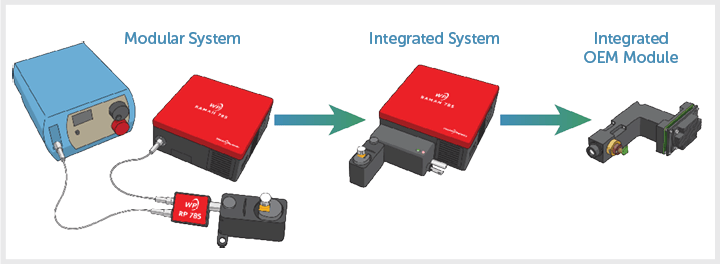
The advantage of this approach to product design is that proof of concept testing and initial research can be performed with modular components to keep the system as flexible and reconfigurable as possible, and with the confidence that important factors like sensitivity, thermal stability, and unit-to-unit variability have already been addressed in the core spectrometer design and will remain consistent throughout the integration process.
Standard product vs OEM module performance
Since our core optical bench remains the same at every stage of product development (modular, integrated, and OEM module), so does the performance. This can be seen in a comparison of 785 nm Raman measurements taken of cyclohexane at 50 ms integration time using a 785 nm Raman system (785 nm integrated laser), as compared to the equivalent OEM module. Note that not only is the spectrometer sensitivity consistent, so is the instrument response function for the two models.
The Importance of Thermal Stability
Thermal stability is extremely important in Raman spectroscopy, as it determines the need for compensation or frequency of recalibration. It also affects the spectral reproducibility, which is extremely important for accurate library matching in a wide range of operating conditions. To validate the thermal performance of our transmissive f/1.3 spectrometer design, we monitored Xe emission spectra taken with our 785 nm ambient (uncooled) Raman spectrometer during temperature cycling, finding thermal shift to be <2 pixels over 0-40°C. A similarly configured f/4 CCT spectrometer experienced a much greater ~5 pixel shift over the same temperature range.
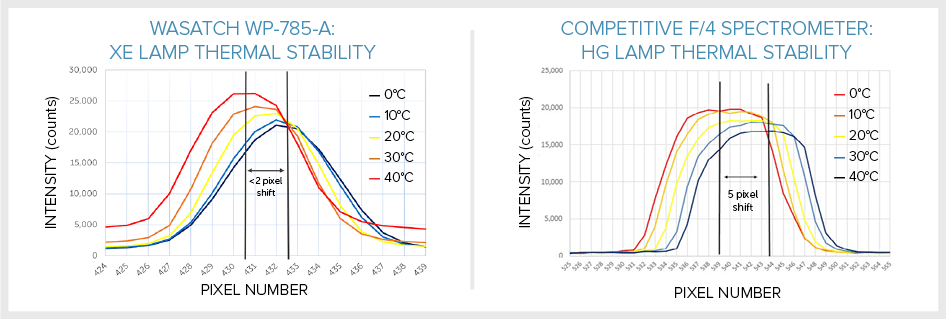
Unit-to-Unit Reproducibility
Reproducibility is an extremely important aspect of spectrometer performance for OEM instrument manufacturers. Peak shape consistency between units is crucial for library building in Raman. Our VPH grating and transmissive f/1.3 spectrometer design have inherently less instrument response function variance from unit to unit as compared to an f/4 reflective CCT spectrometer design. This allows us to offer sensitivity matching as part of our in-house QC for OEMs. The units shown at left were intensity matched to <10% across the full spectrum – at every wavelength!
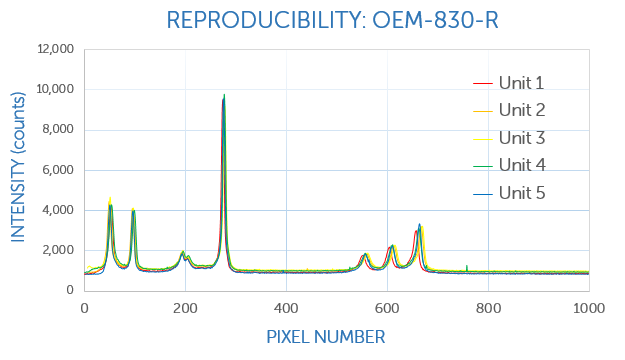
Wavelength – Extend the Choice, Extend the Science
Once confidence in the spectrometer design’s sensitivity and volume manufacturability is established, selection of the right operating wavelength becomes the next important factor. In Raman spectroscopy, excitation wavelength impacts signal level and background fluorescence. Shorter wavelengths offer more signal, while longer wavelengths or near-UV excitation reduce background fluorescence for organic and biological samples. Cost comes into play as well, with many OEMs choosing 830 nm excitation over 1064 nm due to the relative cost of a silicon detector spectrometer vs one with an InGaAs array and TEC cooling. The excitation source may also be a factor, both in relative cost and size, and availability and lifetime (particularly for blue or UV lasers).
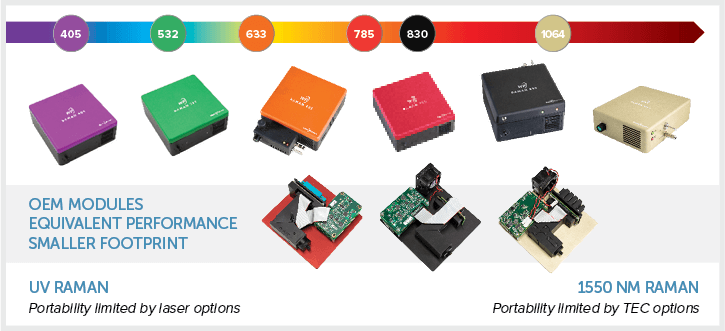
By offering 6 standard wavelengths for Raman – 405, 532, 633, 785, 830, and 1064 nm – and the option to customize wavelength further for OEMs, we give you the flexibility to design the system best suited to your specific sample or application.
Need a different wavelength or bandwidth? As a manufacturer of volume phase holographic (VPH) gratings, Wasatch Photonics is uniquely positioned to design and offer customized gratings perfectly tuned to OEM applications, regardless of the excitation wavelenth chosen. We take the time to understand the needs of each application, balancing needs for bandwidth and dispersion against efficiency using our multiple patented and proprietary grating technologies. Our spectroscopy gratings maximize efficiency and are ultra-low scatter, optimizing SNR.
Conclusion
Wasatch Photonics’ compact, transmissive f/1.3 spectrometer design offers an order of magnitude greater sensitivity and lower limit of detection than conventional reflective f/4 crossed Czerny-Turner spectrometers. Designed for both research and OEM use, our transmissive f/1.3 spectrometer design transitions easily from modular to reduced size footprints with no loss of performance. Additionally, it offers the thermal stability and unit-to-unit reproducibility that is key to advanced identification and quantification methods used for analysis in Raman spectroscopy. If you’re looking to stretch the limits of Raman, this is certainly a good place to start.

